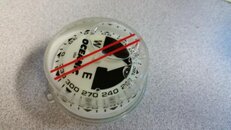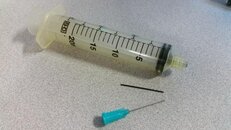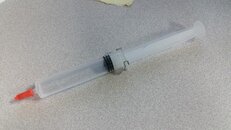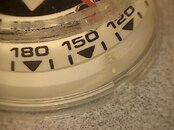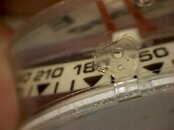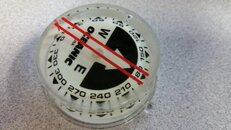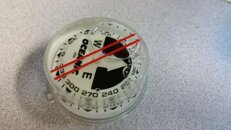brtlmj
Registered
My Oceanic compass developed a large bubble, making it next to unusable. I could have spent $50 and bought a new module. But, being the cheap DIY type that I am, I decided to try to fix it.
Tools and supplies needed:
- Syringe. Bonus points for one that can be capped and locked.
- Needle. (I used a 0.025 in diameter one)
- Small diameter drill – just a bit bigger than the needle.
- Dremel or similar tool.
- Small flat screwdriver
- Appropriate adhesive. A 5 minute epoxy would probably be best.
- Appropriate fluid. I used “cutting board oil” from Home Depot.
In the capsule, there are signs of either the original filling or a previous repair: two holes right next to each other, plugged by adhesive.
I started by drilling a single hole. Using the syringe and needle, I removed some of the old fluid and made sure that it mixed well with the HD oil. Had it not, I would have replaced all fluid instead of adding to it.
I made an attempt at “degassing” the new oil: I put a couple of cc in the syringe, plugged it and then pulled out and locked the plunger, creating mild vacuum. I actually saw a bunch of small bubbles form in the liquid!
I started adding oil to the compass, and very soon understood the reason for the second hole. Basically, getting all the air out is easy, except the very last, small bubble. Then, you may pump as much oil into the compass as you want, but this bubble will then stay away from the needle, kept by surface tension. The extra oil will leak out instead. With a second hole it is fairly easy to maneuver the bubble underneath it. Additional tip: when all the bubbles are gone, do not just withdraw the needle! If you do, you will just "suck" a small bubble back into the capsule. To avoid this, keep on pressing the plunger, so that the volume previously occupied by the needle is replaced by fluid and not air.
The next step is to wipe the capsule as most adhesives do not bond well to oil-covered surfaces. I ended up introducing a tiny bubble back into the compass while doing this.
Then, I covered the holes with a small dab of adhesive. (I used an UV-cured resin called Acrifix 192 because I had some, but it is ridiculously expensive and nobody would buy it just to fix a compass!)
The next day, the bubble got smaller.
Two days later, it was gone. I guess my degassing worked
Damping is acceptable, but on the high side. Had I replaced the entire fluid with oil, damping would be excessive. Mineral spirits of mixture of mineral spirits and oil would probably be preferable.
That's all - I hope it helps someone
Bart
Tools and supplies needed:
- Syringe. Bonus points for one that can be capped and locked.
- Needle. (I used a 0.025 in diameter one)
- Small diameter drill – just a bit bigger than the needle.
- Dremel or similar tool.
- Small flat screwdriver
- Appropriate adhesive. A 5 minute epoxy would probably be best.
- Appropriate fluid. I used “cutting board oil” from Home Depot.
In the capsule, there are signs of either the original filling or a previous repair: two holes right next to each other, plugged by adhesive.
I started by drilling a single hole. Using the syringe and needle, I removed some of the old fluid and made sure that it mixed well with the HD oil. Had it not, I would have replaced all fluid instead of adding to it.
I made an attempt at “degassing” the new oil: I put a couple of cc in the syringe, plugged it and then pulled out and locked the plunger, creating mild vacuum. I actually saw a bunch of small bubbles form in the liquid!
I started adding oil to the compass, and very soon understood the reason for the second hole. Basically, getting all the air out is easy, except the very last, small bubble. Then, you may pump as much oil into the compass as you want, but this bubble will then stay away from the needle, kept by surface tension. The extra oil will leak out instead. With a second hole it is fairly easy to maneuver the bubble underneath it. Additional tip: when all the bubbles are gone, do not just withdraw the needle! If you do, you will just "suck" a small bubble back into the capsule. To avoid this, keep on pressing the plunger, so that the volume previously occupied by the needle is replaced by fluid and not air.
The next step is to wipe the capsule as most adhesives do not bond well to oil-covered surfaces. I ended up introducing a tiny bubble back into the compass while doing this.
Then, I covered the holes with a small dab of adhesive. (I used an UV-cured resin called Acrifix 192 because I had some, but it is ridiculously expensive and nobody would buy it just to fix a compass!)
The next day, the bubble got smaller.
Two days later, it was gone. I guess my degassing worked
Damping is acceptable, but on the high side. Had I replaced the entire fluid with oil, damping would be excessive. Mineral spirits of mixture of mineral spirits and oil would probably be preferable.
That's all - I hope it helps someone
Bart




